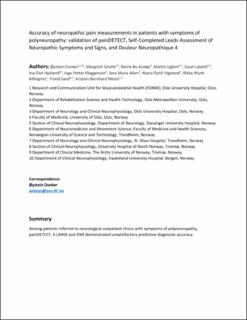| dc.contributor.author | Dunker, Øystein | |
| dc.contributor.author | Grotle, Margreth | |
| dc.contributor.author | Kvaløy, Marie Bu | |
| dc.contributor.author | Uglem, Martin | |
| dc.contributor.author | Løseth, Sissel | |
| dc.contributor.author | Hjelland, Ina Elen | |
| dc.contributor.author | Kleggetveit, Inge Petter | |
| dc.contributor.author | Allen, Sara Maria | |
| dc.contributor.author | Vigeland, Maria Dehli | |
| dc.contributor.author | Killingmo, Rikke Munk | |
| dc.contributor.author | Sand, Trond | |
| dc.contributor.author | Nilsen, Kristian Bernhard | |
| dc.date.accessioned | 2023-02-08T10:21:41Z | |
| dc.date.available | 2023-02-08T10:21:41Z | |
| dc.date.created | 2022-11-20T20:51:50Z | |
| dc.date.issued | 2022 | |
| dc.identifier.issn | 0304-3959 | |
| dc.identifier.uri | https://hdl.handle.net/11250/3049202 | |
| dc.description.abstract | Pain is a common symptom in patients referred to polyneuropathy assessment. Diagnostic evaluation and choice of treatment may depend on whether the pain is likely to be neuropathic or not. This study aimed to investigate the diagnostic accuracy of 3 tools commonly used to differentiate between neuropathic and nonneuropathic pain. To accomplish this, we included patients with bilateral distal lower extremity pain, referred to neurological outpatient clinics at 5 Norwegian University hospitals for polyneuropathy assessment. The patients filled in Norwegian versions of painDETECT, the Self-Completed Leeds Assessment of Neuropathic Symptoms and Signs (S-LANSS), and the clinician-rated Douleur Neuropathique 4 (DN4). All patients underwent a clinical examination and nerve conduction measurements and were classified according to the NeuPSIG neuropathic pain criteria (reference standard). In total, 729 patients were included, of which 63% had neuropathic pain by the reference standard. Only DN4 demonstrated high sensitivity (0.87), whereas all 3 tools had low specificity (≤0.65). Importantly, the tools' predictive ability was unsatisfactory; The probability of getting a correct test result was 3 quarters at best, and at worst, no better than two fifths. Consequently, we show that neither DN4, painDETECT, nor S-LANSS can be confidently used to assess neuropathic pain in a neurological outpatient population with symptoms of polyneuropathy. | en_US |
| dc.language.iso | eng | en_US |
| dc.publisher | Lippincott, Williams & Wilkins | en_US |
| dc.rights | Navngivelse 4.0 Internasjonal | * |
| dc.rights.uri | http://creativecommons.org/licenses/by/4.0/deed.no | * |
| dc.title | Accuracy of neuropathic pain measurements in patients with symptoms of polyneuropathy: validation of painDETECT, Self-Completed Leeds Assessment of Neuropathic Symptoms and Signs, and Douleur Neuropathique 4 | en_US |
| dc.title.alternative | Accuracy of neuropathic pain measurements in patients with symptoms of polyneuropathy: validation of painDETECT, Self-Completed Leeds Assessment of Neuropathic Symptoms and Signs, and Douleur Neuropathique 4 | en_US |
| dc.type | Peer reviewed | en_US |
| dc.type | Journal article | en_US |
| dc.description.version | acceptedVersion | en_US |
| dc.source.journal | Pain | en_US |
| dc.identifier.doi | 10.1097/j.pain.0000000000002793 | |
| dc.identifier.cristin | 2076932 | |
| cristin.ispublished | true | |
| cristin.fulltext | postprint | |
| cristin.qualitycode | 2 | |

